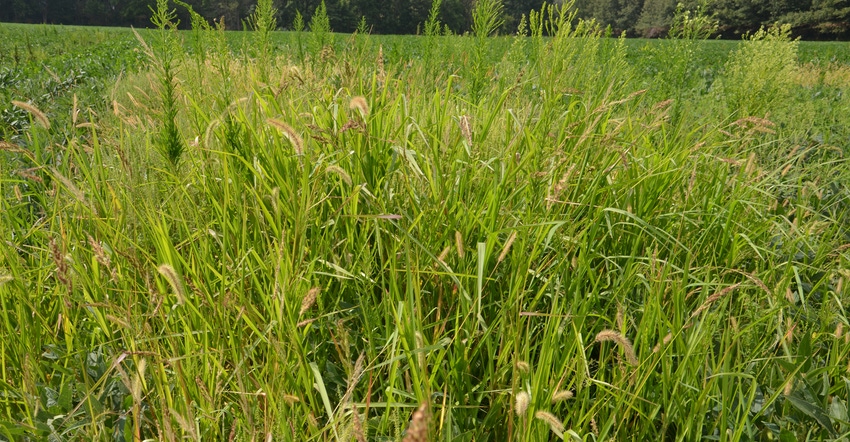December 28, 2017

By Morgan Hasler
Year after year, growers are faced with big problems in their fields regarding weed control. Giant ragweed and marestail are common, and two of the most problematic weeds in corn and soybean crops in the Midwest.
The ragweed problem
Giant ragweed is a complex challenge for farmers due to its emergence period, its resistance to certain herbicides and its interference with crop production. If giant ragweed competes well with other plants, it can grow to be 17 feet tall, weed specialists say.
Giant ragweed tends to be more problematic in soybean fields, notes Bill Johnson, Purdue University Extension weed control specialist. In soybean fields, this weed can produce up to 5,100 seeds per plant, compared to 3,500 seeds per square yard in a cornfield. Giant ragweed has an advantage over other weeds due to its quick growth rate and early emergence. It can compete well with other weeds and the crop for water, nutrients and light because is has large leaves throughout the growing season, he says.
While these characteristics lead to a strong dominance for giant ragweed, there are some things you can do to gain control over the weed.
According to Johnson, the most effective herbicide programs include preemergence and postemergence treatments with at least two modes of action, along with other management programs such as tillage or preplant burndown herbicide applications. He also suggests applying preemergence residual herbicides to reduce competition with other weeds, and applying postemergence herbicides before weeds reach 6 to 10 inches tall.
Erich Hasler, chemical and fertilizer manager at Beck’s, Atlanta, Ind., says, “Along with herbicide programs, there are other alternative genetics to plant that will allow a different mode of action to control early-season emergence of weeds.”
These options include the LibertyLink, Xtend and Enlist systems. They don’t eliminate a residual program, but will assist in postemergence application options.
If you’re looking for an alternative to herbicides, the introduction of cover crops can help reduce weed populations come springtime. It’s a competition concept — meaning that planting radish, cereal rye, rapeseed or a combination of these will be advantageous. Cereal rye is the most common, although weed experts say it’s been more effective with marestail.
Marestail issues
Another dominant weed is marestail due to its height. The weed can be transported very far and easily. Marestail can produce up to 200,000 seeds per plant, experts say.
There are a few influences on marestail that can increase dominance, such as tillage, herbicide resistance and lack of crop rotation. One way to help control marestail is the application of an auxin growth regulator such as 2,4-D ester. Applying this herbicide in the fall after harvest is a good option to help suppress the population, experts note.
The application of 2,4-D ester in the spring will help control marestail that is growing as long as the five-to-seven-day planting delay is achieved when planting soybeans, Johnson says.
Overall, because marestail and giant ragweed are broadleaf weeds, a form of 2,4-D will be effective in the spring.
Controlling these weeds when they’re small and suppressing weed populations as best you can will result in fewer weed problems, Johnson says.
Hasler is a senior in ag communication at Purdue University. Erich Hasler is the author’s father.
You May Also Like




